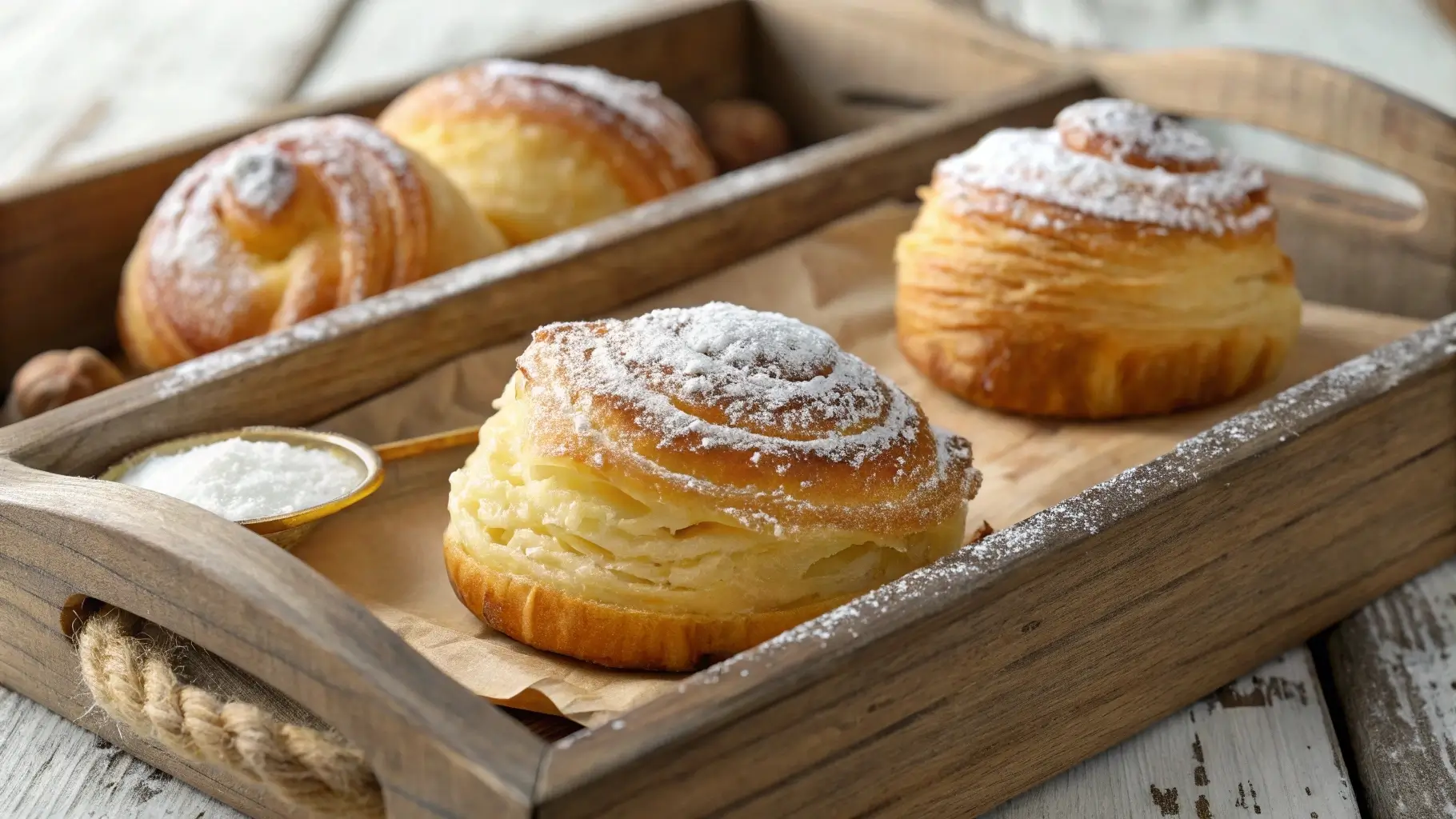Table of Contents
The lobster tail pastry is a marvel of Italian-American baking. With its golden, flaky layers and creamy filling, this dessert is both a feast for the eyes and the palate. Originally inspired by the Italian sfogliatelle ricce, the lobster tail pastry has evolved into its own unique treat, beloved for its larger size and luscious French cream center.
In this guide, we’ll uncover the origins of this delectable pastry, break down the key ingredients you’ll need, and provide step-by-step instructions to help you perfect it at home. We’ll also share tips, variations, and answers to frequently asked questions so you can bake confidently. Whether you’re a pastry enthusiast or a curious beginner, this guide will equip you with everything you need to master the art of lobster tail pastry.
What Is Lobster Tail Pastry?
A Brief History of Lobster Tail Pastry
The lobster tail pastry has its roots in southern Italy, where its predecessor, the sfogliatelle ricce, was first crafted during the Renaissance. This shell-shaped pastry, made with thin, layered dough, was originally filled with ricotta and citrus, creating a dessert that was crisp on the outside and creamy on the inside.
When Italian immigrants brought this tradition to America, they put a creative spin on it. The lobster tail pastry was born—a larger version with an extended shape resembling a lobster tail. Unlike the sfogliatelle, this new creation featured a rich French cream filling, making it both indulgent and uniquely American.
What Makes It Unique?
At first glance, the lobster tail pastry may look similar to its Italian cousin, but key differences set it apart.
- Signature Shape: Its longer, tail-like form gives it a striking appearance, especially when paired with its golden, flaky crust.
- Creamy Filling: Unlike sfogliatelle, which traditionally uses ricotta, lobster tail pastries are filled with a sweet, custard-like French cream. This filling adds a luxurious touch, making it perfect for special occasions or as a dessert centerpiece.
- Crunchy Layers: The secret to the pastry’s iconic texture lies in its laminated dough, which is painstakingly folded and stretched to create dozens of paper-thin layers.
The combination of buttery, crispy layers and velvety filling makes the lobster tail pastry a truly unforgettable treat. It’s no wonder it has become a staple in Italian-American bakeries across the country!
Ingredients You’ll Need for Lobster Tail Pastry
Making the perfect lobster tail pastry starts with assembling the right ingredients. Each component plays a vital role in creating its signature flaky texture and luscious filling.
Essential Ingredients for the Dough
The laminated dough used in lobster tail pastry is key to its light, crispy layers. Here’s what you’ll need:
- Bread Flour: The high protein content in bread flour gives the dough strength, allowing it to stretch thin without tearing.
- Semolina Flour: Adds a touch of structure and a golden hue to the dough.
- Lard or Butter: Traditional recipes call for lard, but butter works well for a slightly richer flavor. Both help create the pastry’s crisp, flaky texture.
- Honey: A small amount of honey adds subtle sweetness and helps the dough come together.
- Water and Salt: These balance the dough’s consistency and enhance the flavor.
The Creamy Filling
The filling is what sets the lobster tail pastry apart from its Italian cousin, the sfogliatelle. It’s typically made with French cream, which is sweet, smooth, and indulgent.
- French Cream: A combination of whipped cream and pastry cream, this filling provides the iconic richness of lobster tails.
- Optional Add-Ins: Pistachio paste, chocolate chips, or lemon zest can be incorporated for a unique twist.
- Powdered Sugar: Used as a finishing touch, it adds elegance and sweetness to the baked pastry.
For more inspiration on how to balance textures and flavors in desserts, check out Strawberry Cheesecake Cinnamon Rolls Recipe.
Step-by-Step Recipe for Lobster Tail Pastry
Creating lobster tail pastry at home requires patience and attention to detail. Follow these steps for flawless results.
Making the Dough
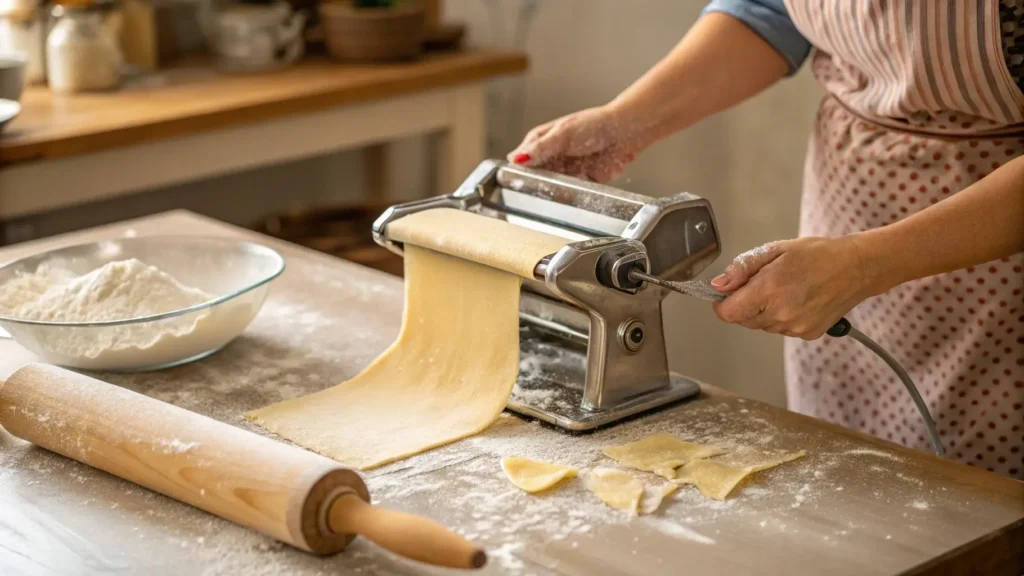
- Combine Ingredients: In a large bowl, mix bread flour, semolina flour, salt, honey, and water. Knead the dough until it becomes smooth and firm.
- Rest the Dough: Cover the dough with plastic wrap and let it rest for at least 2 hours. Resting helps relax the gluten, making it easier to roll out.
- Roll the Dough: Use a pasta machine to roll the dough into thin sheets. Start on the widest setting and gradually reduce the thickness, dusting lightly with flour as needed.
- Layer with Fat: Brush melted lard or butter onto each sheet, stacking them to create the base for the pastry’s signature layers. Roll the stacked sheets into a tight log and refrigerate for 2–3 hours.
Preparing the Filling
- Make the Pastry Cream: Whisk together egg yolks, sugar, milk, and cornstarch over medium heat until thickened. Chill the mixture in the fridge.
- Whip the Cream: Beat heavy cream until stiff peaks form. Gently fold it into the chilled pastry cream to create the French cream filling.
- Optional Additions: Incorporate flavors like vanilla extract, pistachio paste, or orange zest for a unique touch.
Shaping and Baking the Pastries
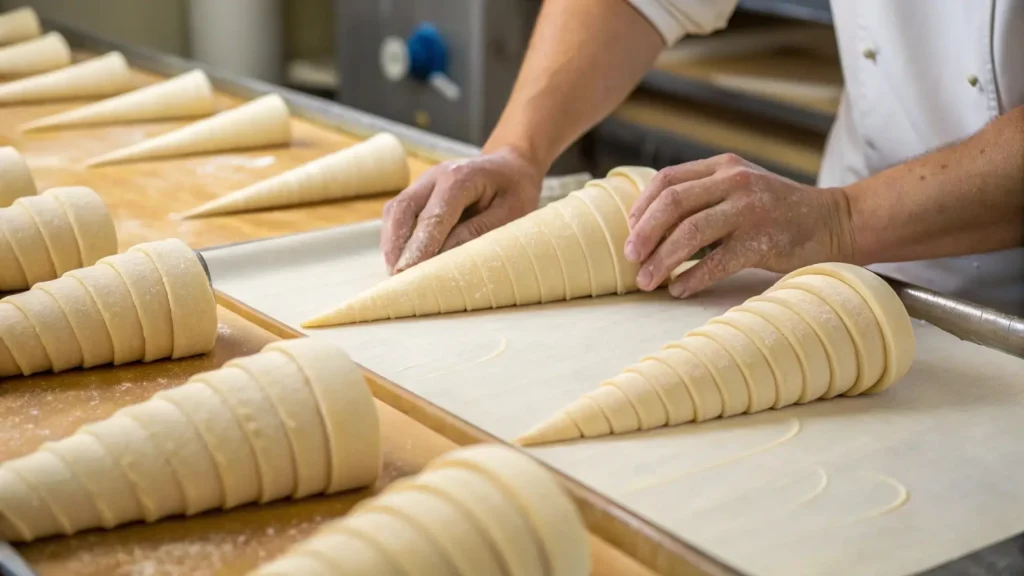
- Slice the Dough: Once chilled, cut the dough log into ½-inch slices.
- Shape the Pastries: Gently flatten each slice with your thumbs, working outward to create a thin, cone-like shell.
- Fill the Pastries: Pipe the French cream into the shells, being careful not to overfill.
- Bake to Perfection: Arrange the pastries on a parchment-lined baking sheet and bake at 375°F for 25–30 minutes, or until golden brown and crisp.
- Finish with Powdered Sugar: Dust the warm pastries with powdered sugar for a classic finish.
Mastering this process might take a little practice, but the reward is well worth the effort. Up next, we’ll explore tips and tricks for ensuring your lobster tail pastry turns out perfectly every time!
Tips and Tricks for Perfect Lobster Tail Pastry
Mastering the art of making lobster tail pastry can seem daunting, but with a few expert tips, you’ll be crafting bakery-worthy pastries in no time.
Avoiding Dough Tearing
The dough for lobster tail pastry is incredibly thin, which makes it prone to tearing. Here’s how to prevent it:
- Rest and Roll Gradually: Always let the dough rest before rolling. A relaxed dough is more elastic and less likely to rip.
- Light Dusting: Use minimal flour when rolling out the dough. Too much can make the layers stiff and brittle.
- Patience Pays Off: Roll the dough in stages, gradually reducing the thickness on your pasta machine. Rushing this step can lead to uneven sheets.
Getting the Filling Just Right
The creamy filling is the heart of a great lobster tail pastry, so getting the texture right is critical.
- Cool Completely: Always chill your filling before piping it into the dough. This ensures it holds its shape during baking.
- Avoid Overfilling: Too much filling can cause the pastry to split or leak during baking. A modest amount ensures the perfect balance of dough and cream.
Achieving Perfect Layers
The pastry’s crispy, layered texture is its defining feature. To achieve this:
- Use Cold Butter or Lard: Keep the fat cold while layering the dough to create distinct, flaky layers.
- Brush Between Layers: Generously brush each layer with melted fat as you stack the dough to lock in crispness.
- Bake at the Right Temperature: Baking at 375°F ensures the layers puff up and turn golden without burning.
For more pro tips on working with delicate doughs, you might enjoy exploring Easy Sausage and Gnocchi Soup for Weeknight Dinners for additional techniques that can translate to pastries.
Popular Variations of Lobster Tail Pastry
While the classic lobster tail pastry is a masterpiece on its own, modern bakers have introduced exciting variations to suit every palate.
Modern Twists on the Classic
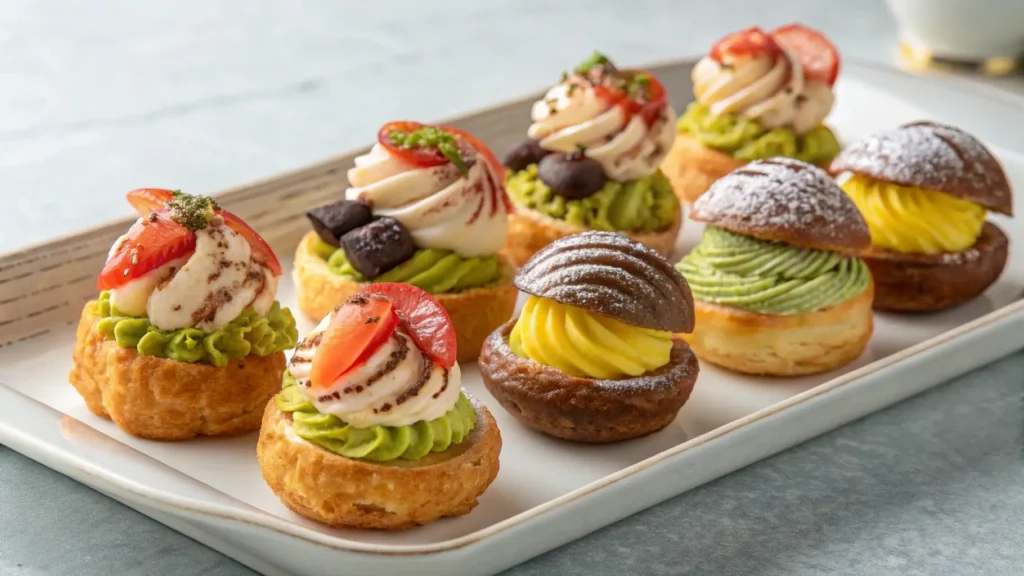
- Pistachio-Filled Lobster Tails: Add a layer of pistachio paste to the French cream for a nutty, flavorful twist. The subtle green hue also creates a visually stunning dessert.
- Chocolate Decadence: Blend cocoa powder or melted dark chocolate into the filling for an indulgent version that pairs beautifully with coffee or red wine.
- Lemon Ricotta: Substitute the French cream with a zesty lemon-ricotta filling. The bright citrus notes make this variation perfect for spring or summer gatherings.
Savory Lobster Tail Pastries
Who says lobster tail pastry has to be sweet? Savory versions are growing in popularity, offering a creative twist on this classic dessert.
- Spinach and Cheese: Replace the cream with a mix of sautéed spinach, ricotta, and Parmesan for a hearty appetizer.
- Prosciutto and Herb: Combine thinly sliced prosciutto with a creamy herb filling for a crowd-pleasing party snack.
Creative Presentations
If you’re serving lobster tail pastries for a special event, consider adding some flair to the presentation:
- Dust sweet versions with powdered sugar and garnish with candied orange or pistachios.
- For savory pastries, serve alongside a dipping sauce like marinara or a creamy béchamel.
No matter the variation, these ideas will add a personal touch to your lobster tail pastry creations.
FAQs About Lobster Tail Pastry
When tackling a recipe as intricate as lobster tail pastry, it’s natural to have questions. Here are answers to some of the most common queries to help you on your baking journey.
Is Lobster Tail Pastry Difficult to Make?
While making lobster tail pastry can be challenging, it’s entirely achievable with patience and practice. The most intricate steps are rolling the dough thin enough for those signature layers and mastering the cream filling. However, by following a detailed recipe and working step-by-step, you’ll find the process manageable. Start small, and as you gain confidence, your pastries will improve with each attempt!
Can You Use Store-Bought Dough?
Yes, you can use store-bought dough as a shortcut, but it won’t deliver the same results as homemade laminated dough. Pre-made phyllo dough or puff pastry can mimic the crisp layers of a traditional lobster tail pastry, but the texture and flavor will be slightly different. If you’re short on time or a beginner, this can be a good starting point.
How Do You Store and Reheat Lobster Tail Pastry?
Lobster tail pastries are best enjoyed fresh out of the oven when their layers are at their crispiest. However, you can store leftovers in an airtight container at room temperature for up to 2 days. To reheat, place them in a 350°F oven for 5–10 minutes to restore their flaky texture. Avoid microwaving, as it will make the pastry soggy.
What’s the Difference Between Sfogliatelle and Lobster Tail Pastry?
The main difference lies in the filling and size. Sfogliatelle, the Italian predecessor of lobster tail pastry, features a ricotta and citrus filling, while lobster tails are larger and filled with rich French cream. Additionally, the lobster tail’s longer shape mimics a lobster’s tail, hence the name.
How to Serve Lobster Tail Pastry
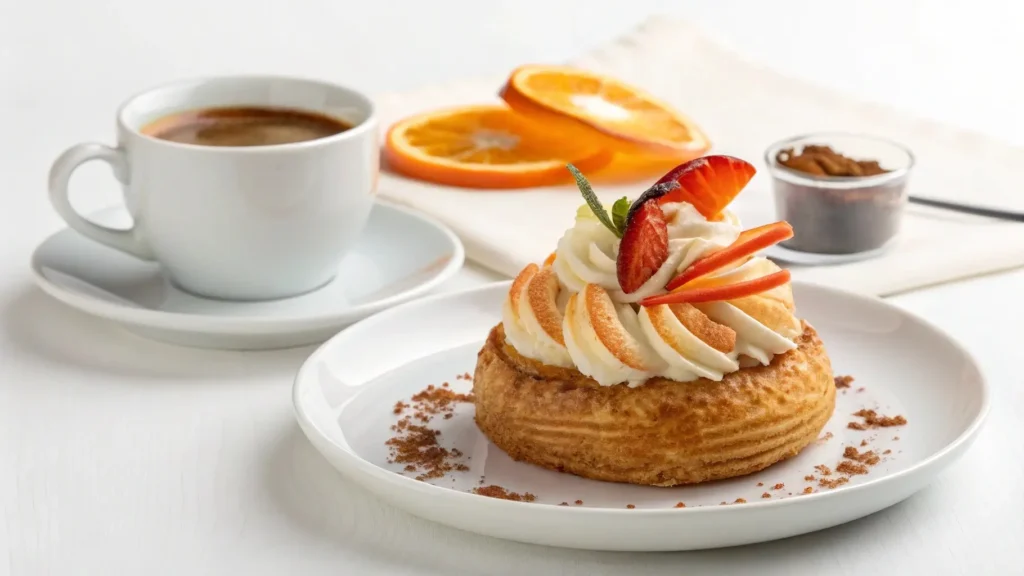
The way you serve lobster tail pastry can elevate it from a simple dessert to a show-stopping centerpiece.
Perfect Pairings for Lobster Tail Pastry
Pairing your lobster tail pastry with the right beverage can enhance its flavors:
- Coffee or Espresso: The pastry’s buttery, creamy richness pairs beautifully with the boldness of a freshly brewed espresso or cappuccino.
- Dessert Wine: A glass of Moscato or Vin Santo complements the sweetness of the French cream filling without overwhelming the palate.
- Tea: Serve with a floral or citrus-infused tea for a light, refreshing combination.
Plating Ideas for Special Occasions
For formal settings or special occasions, consider these creative plating ideas:
- Elegant Dessert Plate: Place the pastry on a small plate, dusted with powdered sugar, and garnish with fresh berries or a drizzle of chocolate.
- Pastry Tower: Arrange multiple pastries on a tiered dessert stand for an eye-catching display.
- Holiday Flair: Add seasonal touches, like candied orange slices in winter or edible flowers in spring, to match the occasion.
With thoughtful presentation and the right pairings, your lobster tail pastry can transform any gathering into a memorable event.
